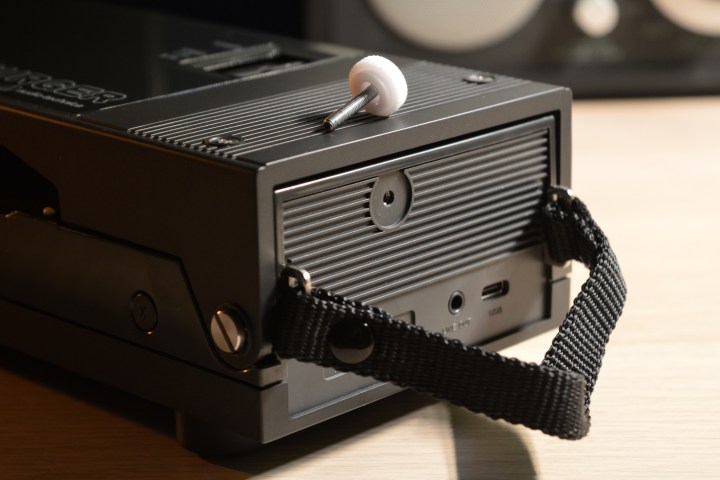“Audio-Technica's Sound Burger puts a modern twist on portable audio with a retro soul.”
- Light and portable
- Easy to use
- Oozing with '80s appeal
- Wired and wireless connections
- Rechargeable battery
- Mediocre sound
- No built-in volume control
- No protective bag
The Audio-Technica Sound Burger is back on the menu. After an initial limited-production run las fall of 7,000 units with the model designation AT-SB2022, the tiny, portable retro turntable is now generally available to anyone with an extra $200 to spend.
At a glance, the AT-SB727 (as it’s officially known) is indistinguishable from the original portable record player that inspired it and debuted in the mid-1980s. But under the hood, it’s got some tweaks that let it play nicely with today’s wireless audio accessories. Can this tiny turntable evoke anything other than nostalgia for a bygone era?
As a staunchly digital-only Gen-Xer, I had to find out.
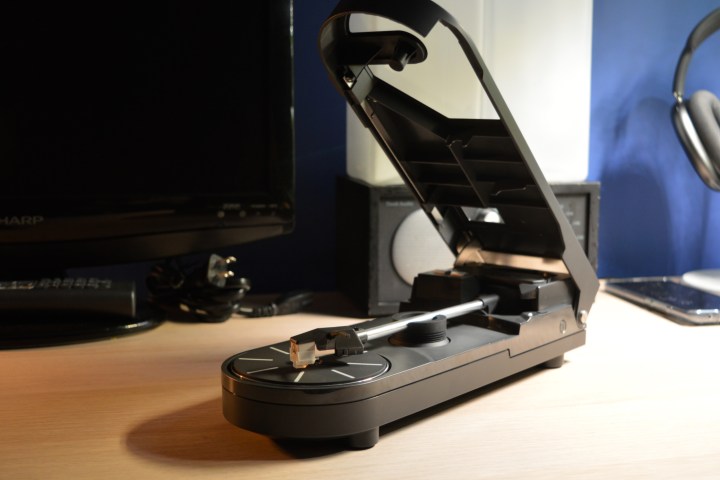
I’m what you might call a vinyl skeptic. I understand that folks take an undeniable joy from the ritual of pulling an album from a shelf, slipping a record carefully from its liner, placing it tenderly on the turntable, and finally dropping the needle. Once upon a time, I too enjoyed this ritual on a daily basis. But then CDs came along and I have never looked back.
As my long-suffering, vinyl-loving colleagues Derek and Caleb will attest, I avail myself of literally every opportunity I can find to mock their sad devotion to what I perceive as an inferior and antiquated technology. But their enthusiasm — coupled with some latent nostalgia for my days staring endlessly at 144 square inches of cover art — made me wonder if there might just be space in my world for record listening. The Sound Burger seemed like the most fun (and inexpensive) way to give it a go.

Retro design preserved
For someone who isn’t sure if their vinyl interest is just a passing fancy or the beginning of a long-term passion, the Sound Burger asks very little in terms of commitment. At just 11 inches long, it’s shorter than the width of a 12-inch record. It’s only 4 inches wide and just under three inches tall, which means you can stow it almost anywhere when it’s not in use.
The shiny black plastic shell (or white, or yellow) and outlined-typeface all hew faithfully to the ’80s-era portable, including a permanent carry strap built into the back. Sadly, Audio-Technica (A-T) didn’t see fit to stick with the original’s inclusion of a protective bag. Unless you want your vintage-looking Sound Burger to acquire a bunch of vintage-looking scratches, you’ll have to buy an appropriately sized cover. What you do get in the box is a USB-C charging cable and a stereo mini-jack-to-RCA patch cord.
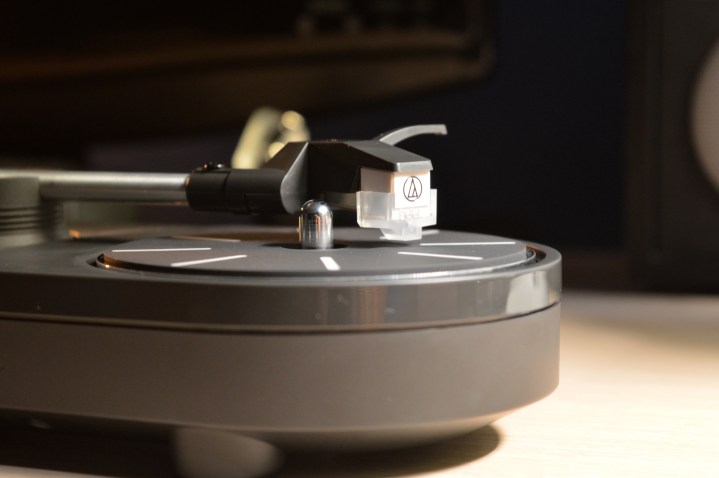
On the bottom are four felt-style feet. These might offer a minor amount of vibration dampening, but they mostly serve to protect the surface under the turntable. If that surface is smooth, be very careful: the felt pads are slippery. When you combine the Sound Burger’s feather weight (just 32 ounces) and those nearly frictionless feet, it makes for a very easy-to-slide product.
This also is where you’ll also find the battery compartment. My hat’s off to A-T on this. Most portable products with rechargeable batteries have sealed, nonreplaceable power cells, but the Sound Burger’s lithium-ion battery is easily swapped (once A-T starts selling replacement batteries).
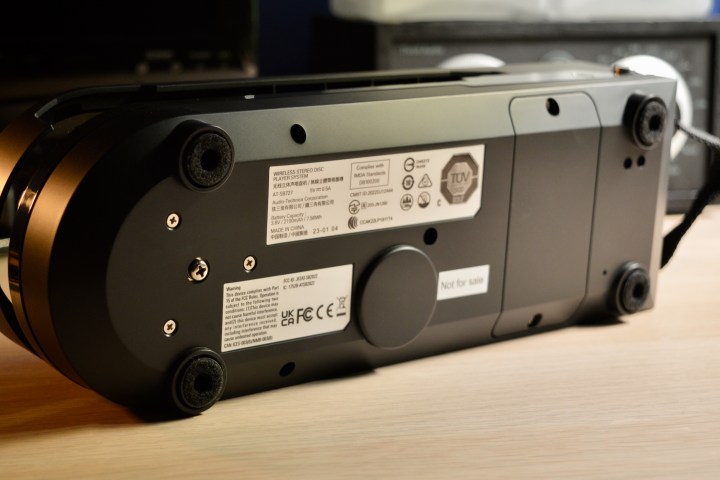
And if you look very closely, you’ll see two tiny recessed holes toward the rear of the bottom panel. Hiding in the depths of those unlabeled holes are two adjustable potentiometers. These let you make fine adjustments to the turntable’s speeds (one is for 33⅓, the other for 45 RPM). Out of the box, 33⅓ was very accurate, while the 45 RPM speed was a hair fast.
Before using the turntable, you’ll need to charge it. If the battery’s empty, that can take an agonizingly long 12 hours — about the same amount of playtime you’ll get once it’s fully charged. A-T doesn’t provide a USB power adapter. But on the bright side, as long as you use the included cable, virtually any charger will do the job — the only requirement is 0.5 amps, which even a basic phone charger can handle. On the not-so-bright side, because of the slow charge rate, if you play records while plugged into power, you won’t gain any battery life. Just don’t lose that USB cable; A-T says other USB cables may not work — I tried a few others I had on hand and, sure enough, some worked and some didn’t.
The other mandatory step before you can start spinning records is the removal of the tone arm fixing screw. This small bolt keeps the tonearm from moving about when you’re transporting it, which feels like an important feature. And yet, once you remove it, there’s no place to store the screw, so you’ll have to find a safe place to keep it. I failed to do that when I set up the Sound Burger initially and now I have no idea where it is.
I realize that A-T wanted to reissue the Sound Burger with as few changes as possible, but it really should have figured out a way to make a built-in latch that could have served the same purpose as a removable screw. I feel the same way about the tiny plastic protective stylus cover. It slides off, which means you’ll need to find a place for that too. A flip-up hinge would have been way more convenient.
You’ll need to decide if you want to play records via Bluetooth or the Sound Burger’s wired output. That seems obvious until you realize that as long as the cable is plugged into the 3.5mm output, Bluetooth functionality is disabled — so you won’t be able to switch between wired and wireless modes seamlessly.
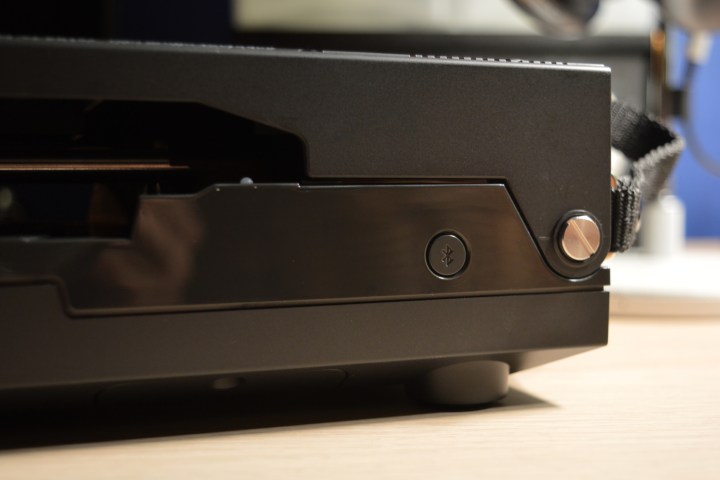
Making a connection
Getting the Sound Burger connected to a Bluetooth speaker or a set of headphones/earbuds is easy: Turn on the turntable’s power by pressing once on the power button, then long-press ( for 2 seconds) the dedicated Bluetooth button to put the turntable into pairing mode, at which point you have roughly 60 seconds to get your other Bluetooth device into pairing mode. As long as the Sound Burger and the other device are near one another, they should automatically pair up. You’ll know it worked when the white light beside the power button starts to pulse slowly.
However, even if you can get your Bluetooth device to pair successfully, you may not get any audio. I had good luck using a set of AirPods Max, a JBL Flip 6 speaker, and a set of Technics EAH-AZ80 earbuds, but when I completed the pairing between the Sound Burger and my Pioneer AV receiver, I simply couldn’t hear any sound. A-T warns you in the manual that this is to be expected — the company does not guarantee that all Bluetooth devices will work with the Sound Burger.
Here’s another consideration if you’re planning to go the Bluetooth route. There is no independent volume control on the turntable for either wired or wireless connections. For most Bluetooth headphones and speakers, this isn’t an issue as they both typically have volume controls built-in. With wireless earbuds, however, this can be way more hit-and-miss. Some models rely exclusively on a connected device like a smartphone for volume control, while others will need to be configured using their companion app to allow for volume adjustments using the earbuds’ onboard controls.
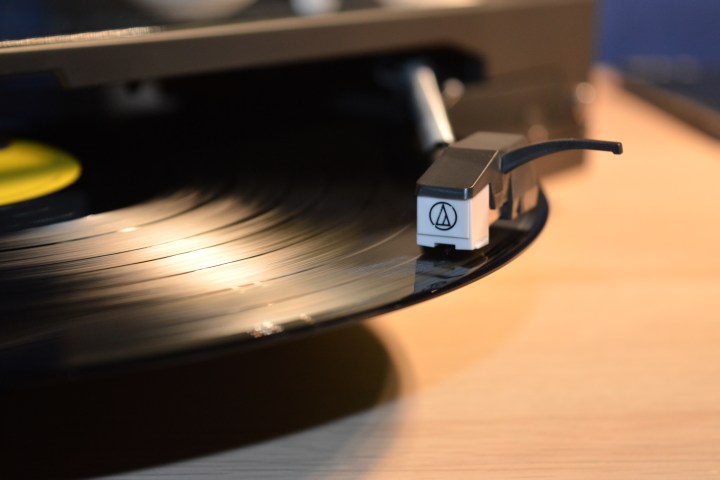
Let me say that last part again: There is no independent volume control on the turntable for either wired or wireless connections. This means that unlike the original Sound Burger, if you connect a set of wired headphones to the 3.5mm stereo output, you’ll be stuck with a single volume setting. A headphone amp with analog inputs and its own volume control would make for a viable workaround.
If you’re using the wired connection, the good news is that the output is already at line level, which means you’ll be able to plug it right into any auxiliary input on your receiver or powered speakers, no phono input or phono preamp needed. But I’m a little disappointed A-T chose not to include a 3.5-to-3.5mm cable in addition to the RCA version, thus saving you the $6 or so .
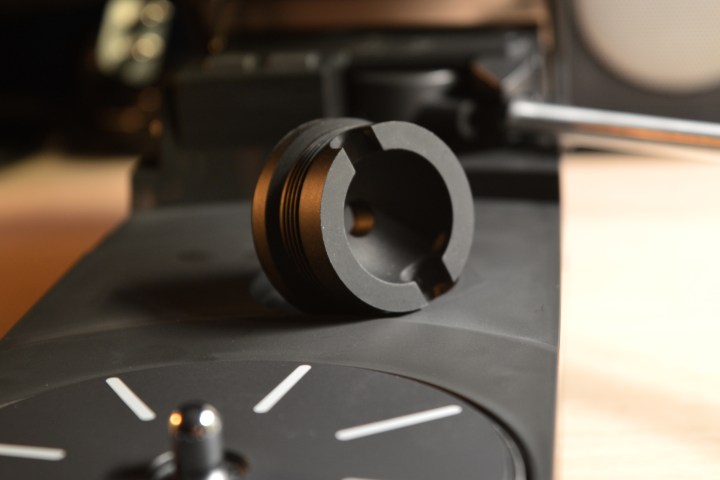
The Soundburger will play both 33⅓ and 45 RPM records, thanks to the speed button that sits right beside the power button. Cleverly, the turntable includes a 45 RPM center hub adapter that also works as a sort of security latch when playing 12-inch records, and it keeps the tonearm stowed when not in use. This is another feature carried over from the ’80s — and it’s another missed opportunity for improvement. A-T could have made the hub adapter magnetic, which would have kept it securely locked in place both when in use and when in storage mode. Not that the fit is loose — it’s actually very snug in both places — but rubber wears over time.
OK, time to play some records!
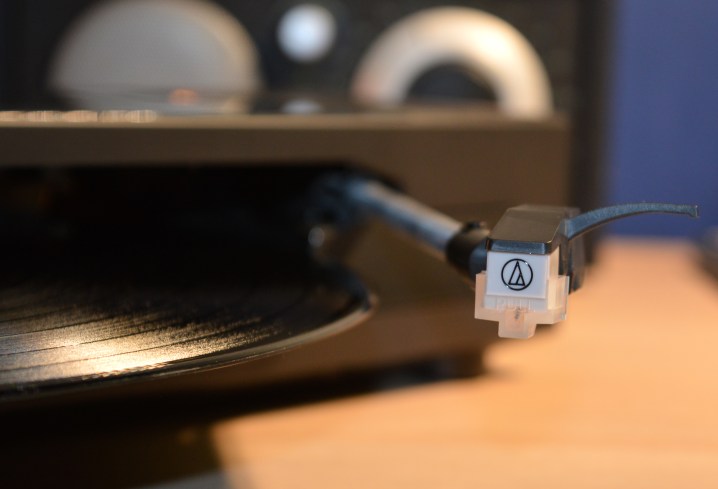
The listening experience
The top cover opens after you release the latch near the front curve. I assume the latch is there for transport purposes (see fixing screw above) — it seems to be unnecessary for playing records.
Unlike normal turntables, which stow the tonearm away from the platter, the Sound Burger’s arm is positioned over the platter when you open the cover. This means you need to follow a specific order of operations. First, release the tonearm from the adapter and then swing it all the way out until it clicks into its standby position. Next, turn the power on. Once you’ve placed a record on the platter, you can swing the tonearm toward the edge of the disc — as soon as you pass that standby click zone, the platter will automatically start at whichever speed you chose using the speed selector button. There is no auto-stop and no cueing lever, so you’ll have to use a steady hand when dropping and lifting the needle.
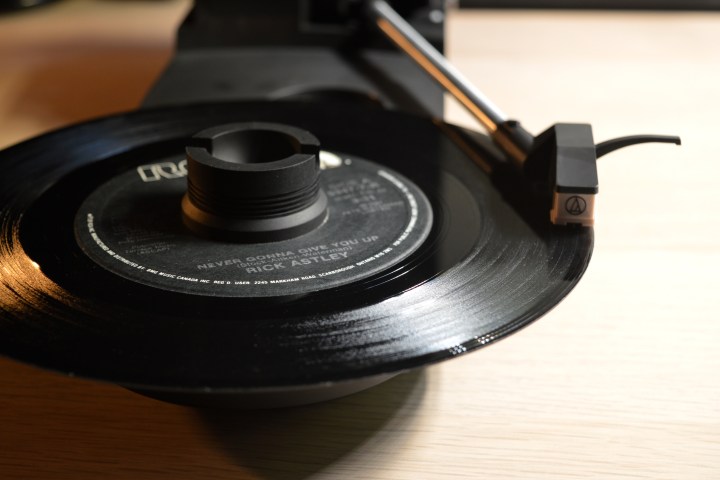
With the adapter hub in place, 45s feel like they were made for the Sound Burger’s tiny platter, which is exactly the same diameter as a record’s center label. With 12-inch vinyl, you quickly realize that warping could be a problem. The platter only sits about a millimeter proud of the turntable’s chassis. Since 12-inch discs extend into the body, where they are unsupported by the platter, a badly warped album could easily rub against the bottom. It feels like the kind of thing that could have been helped if A-T had included an optional, thicker slipmat — there’s definitely enough room to accommodate one.
Listening to the Sound Burger is fun, especially when using a set of Bluetooth headphones. By now, we’re all very used to wireless digital music, but knowing that you’re listening to spinning vinyl from across the room, with no wires? It’s kinda cool.
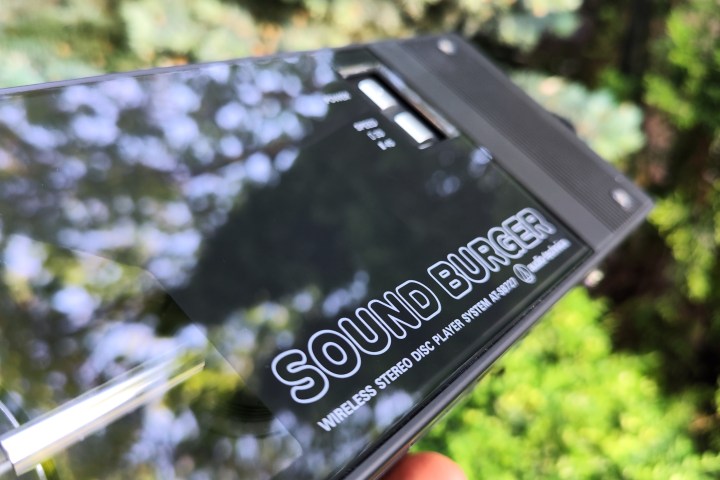
But at least in terms of sound quality, you’ll need to keep your expectations in check. The Sound Burger, with its focus on nostalgia-fueled portable playback, is not an especially hi-fi device. Whether you’re listening via a wired or wireless connection, music can feel a little lifeless.
For my audition, I hauled out the only vinyl my family owns: a just-opened rerelease of the Ramones’ Rocket to Russia, Yes’ 90125, Reggatta de Blanc by the Police —and because I couldn’t resist teasing my wife, her ancient single of the internet’s favorite song, Never Gonna Give You Up by Rick Astley.
The AirPods Max delivered clean, balanced sound, with decent stereo separation, but it lacked punch and the dynamic range felt constrained. I handed the headphones to my 18-year-old daughter and her reaction was the same as mine: underwhelmed.
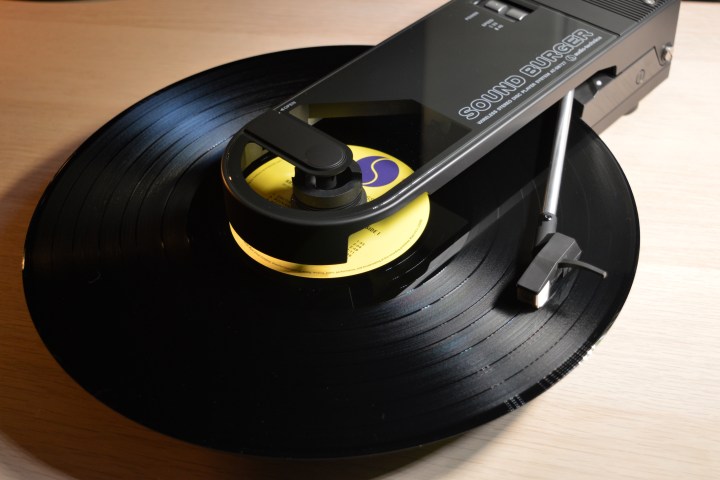
We felt the same way when listening to JBL Flip 6, and when we piped the Sound Burger into a Sonos Era 100 via the smart speaker’s USB-C line-in adapter.
Not being much of a vinyl guy, I’m guessing this has more to do with the components than the wired or wireless connection. The cartridge is a fixed, variable magnet design (similar to a moving magnet cartridge), with an ATN3600L conical stylus. This $24 needle is easily swapped out once it outlives its useful service period, and it definitely gets the job done, but it hardly qualifies as a precision instrument.
To put this belief to the test, I played the same albums on our Victrola Stream Carbon review unit with both the Stream Carbon and Sound Burger operating in wired mode. The Stream Carbon uses an Ortofon Red 2M cartridge and, predictably, things sounded a lot better. The depth, tone, and energy that I know these discs should possess were all far more apparent on the Victrola.
It’s not a fair comparison, and I had no reason to think the Sound Burger would come anywhere close to the Stream Carbon. I only bring it up as a reminder — if you want prime rib, you don’t order a burger.
For $200, the Audio-Technica AT-SB727 Sound Burger is an affordable and fun way to bring the joy of playing vinyl back into your life if it’s been absent for a while, or to introduce it to a younger generation. While its sound is unlikely to wow you, its authentic mid-80s design is a blast of nostalgia for those who remember that era, while its Bluetooth capability means it will be enjoyed by just about anyone who turns it on.


